|
One of the 2009 formations which attracted a lot of attention was this one, which appeared in the field across the A4 from Silbury Hill. A Los Angeles film crew happened to be conducting a "night watch" on top of Silbury Hill the night this formation occurred and, although they were awake and watching all night, they neither saw nor heard anything unusual during the approximately 5 hrs. of darkness before one of their group discovered the circle at first-light, around 4:30am.
A camera-man from the film crew was the first person into this formation and he arrived about 20 minutes after first discovering it, before the sun had yet risen. His footage (which I have seen) clearly shows node bending was present immediately, and in multiple plant stem nodes inside the circle.
We were curious about this formation and pleased to learn that our BLT fieldworker did visit it, although not until 25 days after it had appeared and, unfortuntely, only briefly. Because there were other formations he wanted to examine on this trip, he did not spend as much time in this formation as we now all wish he had.
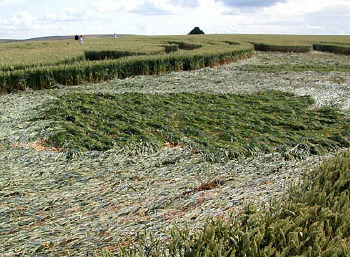 |
|
One section of unusual lay pattern around top of "mask" which
creates undulating light reflection in aerial shots.
Photo: Mike Callahan
|
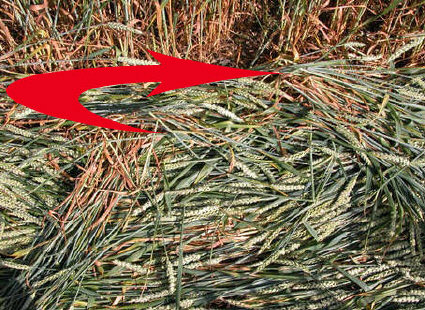 |
|
Plant stem nodes in flattened sections are bent downward rather than up
(as they would be 25 days after the formation occurred if
bending was due to photo -- and/or gravitropism).
Photo: Mike Callahan
|
The few samples we have from the "Mayan Mask" were obtained 25 days after it appeared and, in comparison to the controls, do not exhibit any obvious signs of developmental inhibition of the seed-heads.
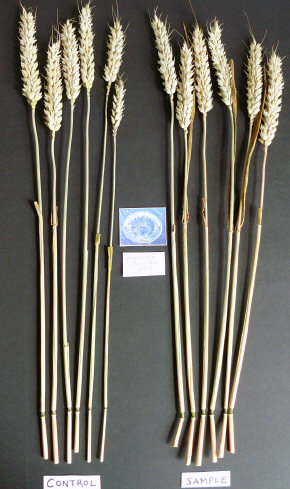 |
|
Seed-head development appears unaffected 25 days after
the July 5th "Mayan Mask" occurred, but moderate
apical node elongation can be seen.
|
But in addition to the downward-bending nodes in Mike Callahan's photo (above), we can see that the apical nodes (1st nodes beneath the seed-heads) do show moderate elongation in our few samples, as well as expulsion cavities in several of the 2nd nodes.
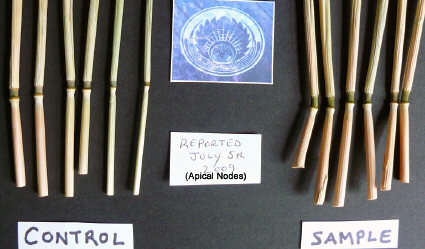 |
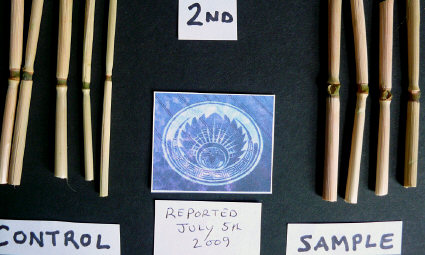 |
|
Sampling 25 days after "mask" appeared shows some apical node
elongation & expulsion cavities in 2nd nodes.
|
We can offer only a tentative conclusion regarding this formation's origins based on (a) the fact that node bending was filmed within a half-hour of the circle's discovery, (b) the node bending is downward (instead of upward as would be the case if caused by photo- and/or gravitropism), (c) there is moderate apical node elongation in the few samples we have, and (d) there are some expulsion cavities in the 2nd nodes -- all of which indicate exposure of the plants to energies known to be associated with a plasma discharge.
Had the sample size been considerably larger and the apical (top) node elongation and presence of expulsion cavities in the 2nd nodes been a consistent finding in a much larger sample, we would have been able to be much more certain.
Strange Camera Effects
We do have an interesting anecdote regarding this formation. Sometime between July 27th-July 30th a small group of tourists, including Dean and Margaret DeHarpporte from Minnesota, were visiting the "Mayan Mask." Margaret had taken a few photos (all normal) with their digital camera when they first arrived, but a British TV production crew was interviewing one of the group and she turned the camera off and handed it to her husband, who put it in his pocket and then lay down to wait for the interview to be over.
Dean thinks the interview went on for a good half-hour, perhaps longer. When it was finally over he got up and turned his camera back on to take a few more photos before the light faded -- but immediately saw a very strange image appear on his LED screen. He realized that, when he pointed the camera at one or another section of the field, he could see what was actually in front the lens-but only faintly, and behind the odd LED display.
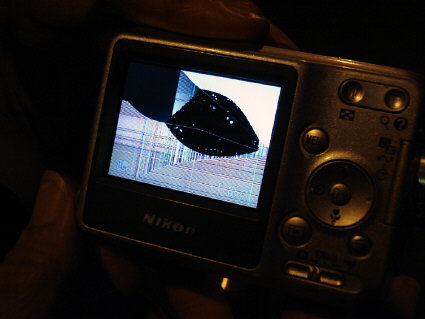 |
|
Strange LED image which appeared on the DeHarpport's camera while inside the
"Mayan Mask." The image stayed on the LED screen in spite of new
batteries being installed. Photo: Lindy Tucker
|
When the chip was taken out of this camera and placed in another so the photos previously taken could be viewed, this image on the LED screen was not on the camera's chip -- so it is not an actual photograph, but some sort of artifact on/in the LED screen itself. It is possible that Dean may have damaged the camera by lying on it, thus causing this odd LED display, but photos taken subsequently with the camera appear normal, with no trace of this LED screen image on the new photos -- although the camera's shutter mechanism now "rapidly closes and opens after a photo is taken until the camera is given a whack to make it quiet down." And the peculiar LED screen image re-appears after new photos are taken.
Interestingly, the British TV crew which was in the "Mayan Mask" at the same time as the DeHarpports, upon seeing the strange image on Dean's LED screen, remarked that one of their professional TV cameras had "failed completely" while they were filming in this formation a few days earlier.
Another totally separate and quite peculiar incident occurred during the DeHarrporte's 2009 UK visit. Upon their arrival to their Marlborough hotel, the key to their room suddenly softened "like jelly" and twisted as Dean inserted it into the lock, making it impossible for them to open the door. They were unable to get into their room and another key had to be made. Dean reports that the key was not hot when it softened spontaneously and said that this was the first time he had personally experienced anything as unusual as this.
Small Components of Formations Often Show
Greater Plant Changes
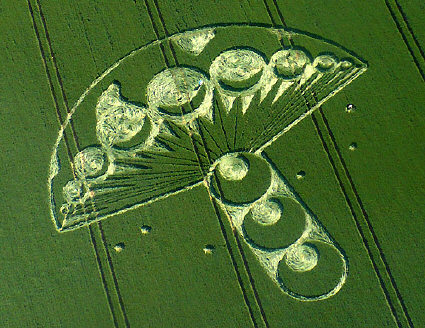 |
|
June 24, 2009 -- Rough Hll "mushroom," in wheat.
Photo: Russell Stannard
|
An additional formation examined by our fieldworker appeared on June 24th at Rough Hill. Over the years the BLT work has often revealed greater damage to the plants in smaller circles, or smaller components of larger formations, than that which is found in the larger circles or in the larger flattened sections of some formations. Since the deleterious effects to the plants are thought to be caused by microwave radiation exposure (the energy that causes reduction in seed-head growth, elongation of the apical nodes and the expulsion cavities), it makes sense that the radiation in smaller, more confined areas might be more intense, thus causing greater visible plant damage.
The plant changes found in Sample B (taken from the small "grapeshot" on the left, nearest the tramline in photo above) revealed a clear reduction in seed-head development -- which was not seen in Samples A and C, taken from larger downed-crop areas. All three sample sets did contain expulsion cavities in all of the 2nd nodes beneath the seed-heads, as well as in some of the 3rd nodes.
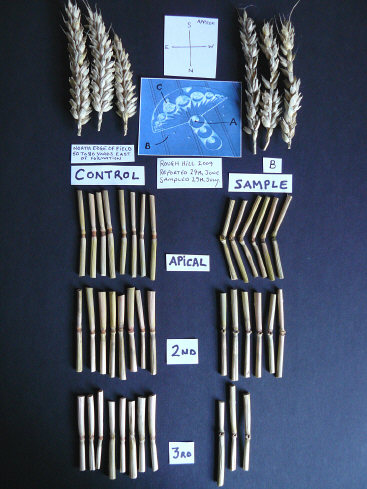 |
|
Sample B (from small "grapeshot"), taken 1 month after formation appeared,
shows inhibited seed-head development -- not found in samples A & C,
taken from larger areas of flattened crop.
|
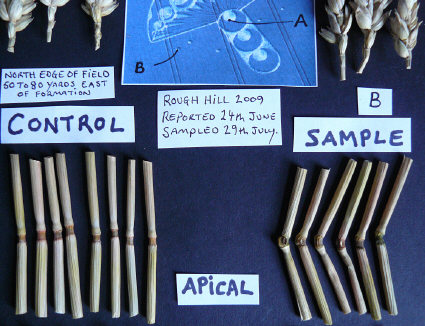 |
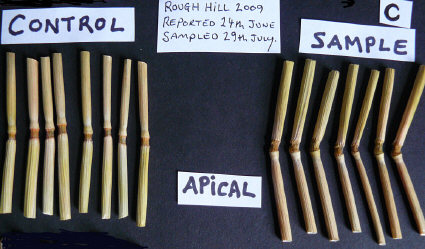 |
|
Apical node elongation, if present here, is subtle & would therefore
require more extensive sampling with laboratory measurements
& statistical analysis to ascertain.
|
Effects to Plants Along Tram-Lines Which
Run Through Formations
Expulsion cavities, one of the primary visible plant changes associated with authentic crop circles (and which have been found only very rarely in the many thousands of control plants examined by BLT over the years), can also occur in plants bordering the tram-lines -- particularly, but not exclusively, in tram-lines which run through the crop circle itself. If microwave radiation (one of the energies involved in the plasma discharge and the one which we believe is instantly turning the moisture inside the plant stems -- most particularly at the nodes -- into steam) is what is causing the exposed plant nodes to "explode," then finding similar effects caused by the microwaves in plants along these tram-lines makes very solid sense.
Plasmas (electrified air masses which carry electric charge when traveling through a magnetic field) emit microwaves when they spiral -- and certain shapes called "waveguides" -- attract plasma "like bees to honey" (see John Burke's article "The physics of Crop Formations," sections entitled "Natural Causes" and "Deterministic Chaos" on the Published Papers section of the BLT web-site: http://www.bltresearch.com/published/physics.html). The long straight tractor lines (which function like 3-sided rectangles) are one well-known waveguide shape which, in the crop circle situation, can channel the microwaves for a considerable distance away from the actual formation, thus exposing the plants along these tram-lines to some of the radiation involved in the plasma discharge which creates the actual formation.
Our fieldworker paid special attention to the tram-lines running through formations and some which did not, and also looked at the tram-lines in the corners of fields, where the tractors often turn around. We do not yet have enough data to complete a report about plant changes sometimes found in these areas, but hope to gather enough data in the next few years to do so.
In the Rough Hill formation (and several others we examined in 2009) we did find some expulsion cavities (and a few elongated apical nodes also) in plants running along tramlines that went through the actual formations themselves, but at a considerable distance away from the crop circles.
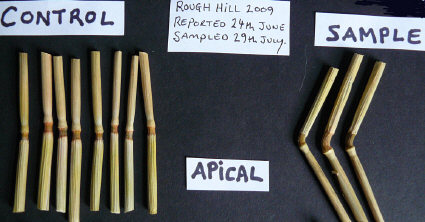 |
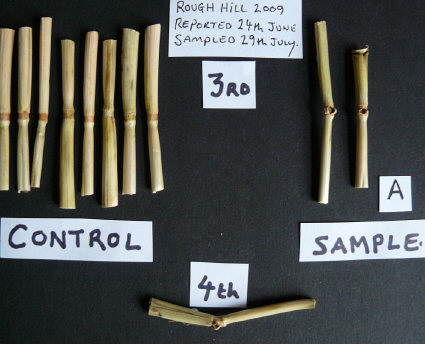 |
|
Elongated apical nodes and expulsion cavities in 3rd & 4th nodes
in plants along tram-line running through Rough Hill circle.
|
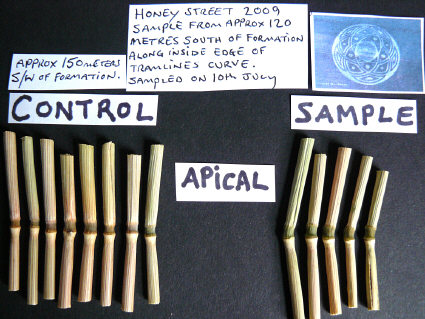 |
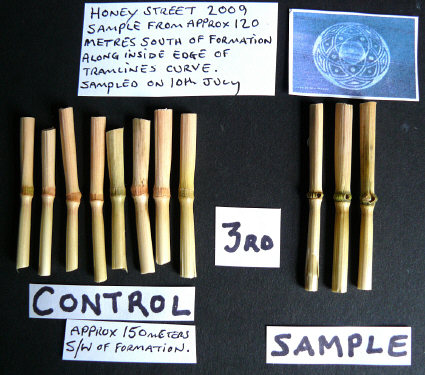 |
|
Possible apical node elongation and expulsion cavities in 3rd nodes of
plants in tram-line 120m south of Honey St. formation.
|
We suspect that the changes sometimes found in plants along the edges of tram-lines -- particularly those tram-lines which run through crop circles -- is evidence that these long straight lines in the fields are functioning as wave-gudes. Whether it is the intensity level of the microwaves in any particular event, or the length of time involved in their discharge, or perhaps the angle of impact or the overall size and/or complexity of the plasma energy system itself which dictates in which instances tram-lines would function in this manner remains to be discovered.
The fact that these plant changes are also occasionally found in tram-lines not directly related to existing formations or in corner areas of some fields where no formation exists needs more research to understand.
Are Plants in Entire Fields Affected When Large
and/or Multiple Circles are Present?
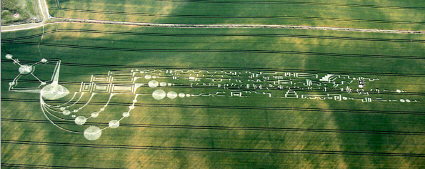 |
|
400m-long formation beneath Milk Hill which appeared in 3 stages on
June 21, June 23 & June 30, 2009. Photo: Olivier Morel
|
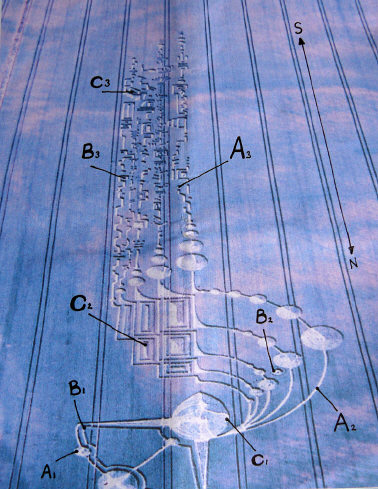 |
|
Samples taken in each stage (A1, B1, C1 & A2 = Stage #1;
B2, C2=Stage #2; A3, B3, C3=Stage #3).
Photo: Lucy Pringle
|
This amazing formation is very difficult to evaluate -- not only because of its enormous size, but primarily because the apical nodes in the control plants (all taken from the SE corner of this field) look nearly as elongated as are the apical nodes in the samples. Additionally, seed-head development in all of the samples appears normal and there were no expulsion cavities found in any of the 2nd nodes, and only a very few in the 3rd nodes. These conditions are the same in all the samples taken from each of the three "phases" of this formation.
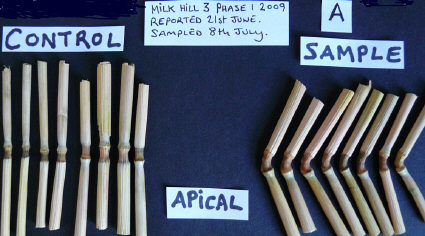 |
|
Close examination of the apical nodes from Sample A in phase #1
reveals considerable node elongation -- but so do many of
the "control" plants from the SE corner of the field.
|
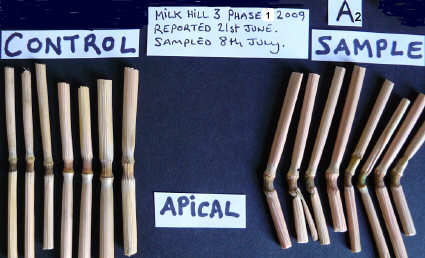 |
|
This is also the case with Sample A-2 (also from phase #1,
although our fieldworker mistakenly marked it
originally as coming from phase #2).
|
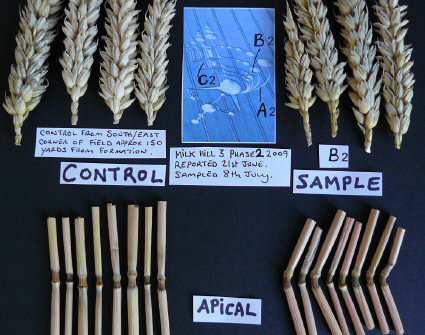 |
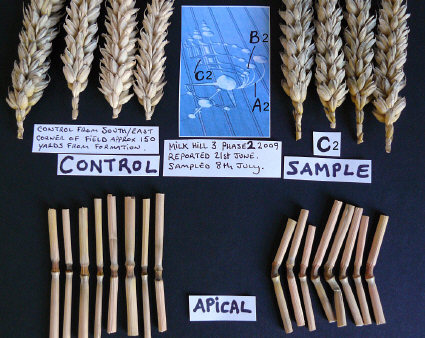 |
|
Two sets of samples from phase #2 (June 23rd) which again reveal
normal seed-head development and apical node elongation
in the samples, but also in many of the "controls."
|
The problem here, of course, is how to interpret these results. Apical node elongation ("stretching" or "lengthening" of the first node beneath the seed-head) is the best-documented and most reliable visible plant change indicating authenticity established by the BLT work during the 1990s. The presence of expulsion cavities found in the lower stem nodes is also a strong indicator, but we know that these do not always occur in genuine formations (circles in which in-depth sampling and subsequent lab analysis in the past documented enough other factors to indicate authenticity) -- and based on our earlier work we know that this is particularly true of British formations.
So, in this case, where pronounced apical node elongation does appear to be present (but in both the samples and the controls) -- but with no expulsion cavities in the 2nd nodes and only a few in the 3rd nodes -- and with what also appears to be normal seed-head development in all of our samples, we're again confronted with the need for much more extensive sampling and statistical analysis, as well as germination trials and other laboratory analysis.
However there are two other factors which may be applicable here. We know, from previous work, that in some formations there is what we have termed a "spillover" effect -- a situation where the nodes of standing plants outside formations have been found to be altered up to a distance of 350 ft. away from certain formations which occurred in the 1990s. In these cases the actual "control" plants did not begin until our samplers were 350 ft. away from the flattened crop circles.
Therefore, in this case, we probably must consider the number of formations which were already present in the adjacent field, in addition to the small 2-phase circle which occurred in the S-SE area of this very same field and on two of the exact same nights as did phase #1 and #2 of the huge 3-stage formation.
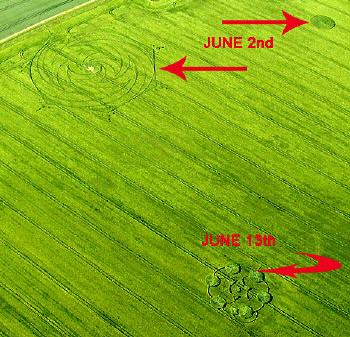 |
|
Three circles already present in field adjacent to one in which the
3-phase formation later appeared.
Photo: John Montgomery
|
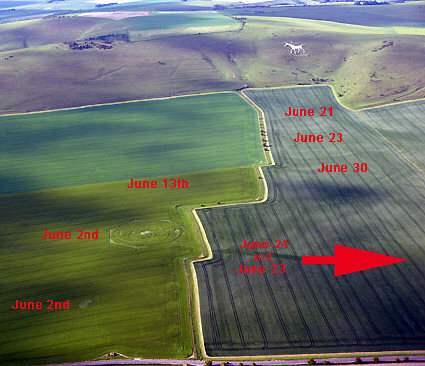 |
|
June 2 & June 13th formations next to field in which 3-phase event
& small June 21-23 circle also subsequently occurred.
Photo: John Montgomery
|
We must also note that this small (and atypically-flattened) circular area in the southern section of the field below the white horse was also found to have an "addition" on the same date that phase #2 of the larger formation was discovered. With this amount of activity in a relatively small area it is possible that many, if not all, of the plants in the 3-phase Milk Hill field could have been repeatedly exposed.
 |
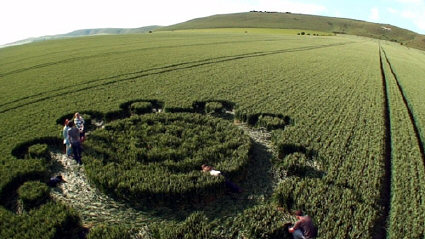 |
|
Phase #1 (top) of small crop circle found on June 21st and with "addition" (bottom)
found June 23rd; this circle was in southern section of same field in which
3-phase formation also appeared. Photo: Stuart Dike.
|
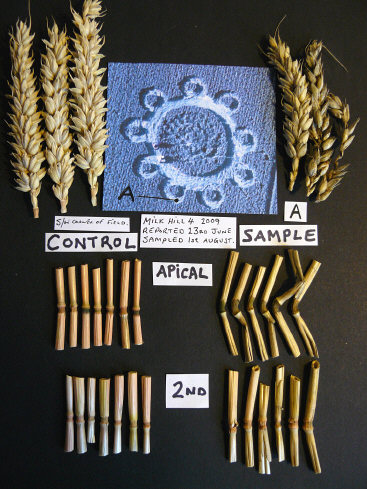 |
|
Sample A from the 2nd phase of the small unusual circle at Milk Hill
(Milk Hill #4) reveals impaired seed-head development, extreme
apical node elongation & expulsion cavities in 2nd nodes.
|
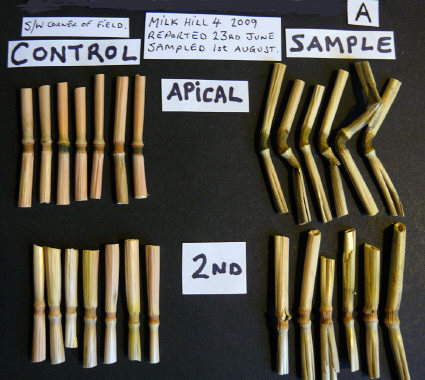 |
|
Extreme apical node elongation is clearly present in the sample plants
when compared to controls taken from SW section of the
Milk Hill field.
|
Finally, and I think most importantly, we must consider the (in retrospect) unfortunate fact that our fieldworker took all of his "control" plants for this huge Milk Hill 3-phase formation from the SE corner of that field. It turns out that there were several small, odd, flattened areas in this section of the field, as well as the smaller 2-phase circle ("Milk Hill #4," arrow) whose first phase was found on the same date as phase #1 of the larger event and whose second phase appeared on the same date as phase #2 of the larger formation up closer to the white horse.
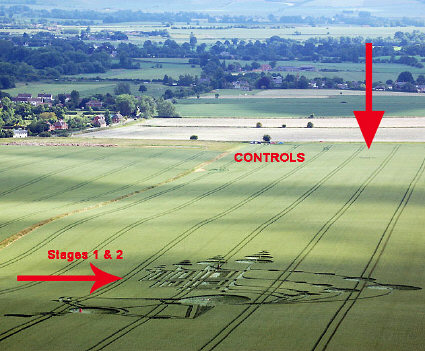 |
|
Proximity of 3-phase formation, the smaller Milk Hill #4 circle (arrow) & the
SE corner of field where controls for 3-phase event were taken.
Photo: Stuart Dike.
|
Since we know from the intensive sampling and lab analysis carried out by BLT in the 1990s that a "spillover" effect into standing crop beyond the flattened perimeters of crop circles can -- and does -- occur in some events, and because all of the "controls" for this 2009 3-phase formation at Milk Hill were taken from an area that might well have been affected by other plasma discharges in several other events nearby, and also because we have never seen "control" plants previously in which the apical nodes looked as affected as those in these "controls," we have reason to ask seriously if we actually have any real "controls" for the 400m-long, 3-phase formation.
It is my personal opinion, based on 10 years of scientific evaluation of crop circle plants and my continuing expeditions into crop circle fields in multiple countries and my examination of plants in those situations, that significant apical node elongation is present in our samples from this extraordinary 3-phase Milk Hill event. And I also think that our "controls" taken from that SE corner of the Milk Hill field had also been affected, thus rendering them ineffectual as "controls." If we had obtained controls from multiple different areas of that field, I think we would have been able to clearly prove this.
As has been previously stated, very large and/or complex formations such as this one require not only extensive sampling, but laboratory evaluation, to be able to come to a reasonable assertion regarding causation. But in those hundreds of cases examined by BLT in the 1990s we never saw crop circle samples in which apical node elongation was present to this degree without additional evidence (from germination studies and/or soil analysis) also indicating authenticity -- studies which we were not able to carry out here. And so, in spite of my original impression that this extraordinary formation was almost certainly mechanically created (not least because it's appearance was so singular), after seeing the clearly elongated apical nodes in all the sample sets from all 3 phases, and after seeing the control plants for Milk Hill #4 which were all taken from the SW corner of this same field, I think it's possible this one could be the "real McCoy."
As will be seen in Part 3, plant changes in samples from the other similarly novel UK crop circle of 2009 provide some support for this opinion.
Continue to Part 3 >>
|